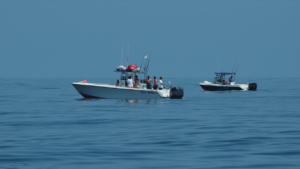NCCOS scientists completed the first stage of a collaborative and multidisciplinary study of visitor use patterns at Gray’s Reef National Marine Sanctuary. Understanding visitation at this marine protected area will enable sanctuary managers to make informed decisions that affect visitors, understand impacts to the site, and increase efficiency of enforcement activities.

Gray’s Reef National Marine Sanctuary, off the coast of Georgia, is one of the largest near-shore “live-bottom” reefs of the southeastern United States. The sanctuary teems with more than 200 fish species, several of which are targeted by recreational anglers that visit this offshore site in small boats.
Obtaining visitor use pattern information has challenged the Sanctuary since it was founded in 1981 due to its distance offshore, lack of monitoring resources, and technological limitations. The study report addresses these challenges through analysis of satellite, hydrophone, aerial, buoy camera, and on-water surveys to understand the daily and seasonal patterns of use.
The study, a product of the NCCOS project Patterns of Visitation at Gray’s Reef National Marine Sanctuary, provides sanctuary managers with actual visitation statistics. This information is especially timely given the upcoming Sanctuary Management Plan Review and associated Condition Report.

Apart from general visitation statistics, a key and immediate application of this information is to determine boater compliance with the designated research area (only transit and approved research activities are allowed). Gray’s Reef National Marine Sanctuary and their law enforcement partners can use the data to more efficiently deploy their limited resources when most needed. The next stage in this research determines how different weather patterns and calendar dates, such as weekdays versus weekends, holidays, and tournaments affect visitor use throughout the year.
Citation: Kendall, M.S., T.A. Battista, M. Carson, W. Caskey, K. Grissom, B. Guthrie, M. Head, C.F.G. Jeffrey, M. Kuzemchak, K.W. Roberson. T.J. Rowell, B. Shortland, and J.A. Stanley. 2020. Observations of Visitation to Gray’s Reef National Marine Sanctuary. NOAA Technical Memorandum NOS NCCOS 281 Silver Spring, MD. 57 pp. https://doi.org/10.25923/hct8-6y08
